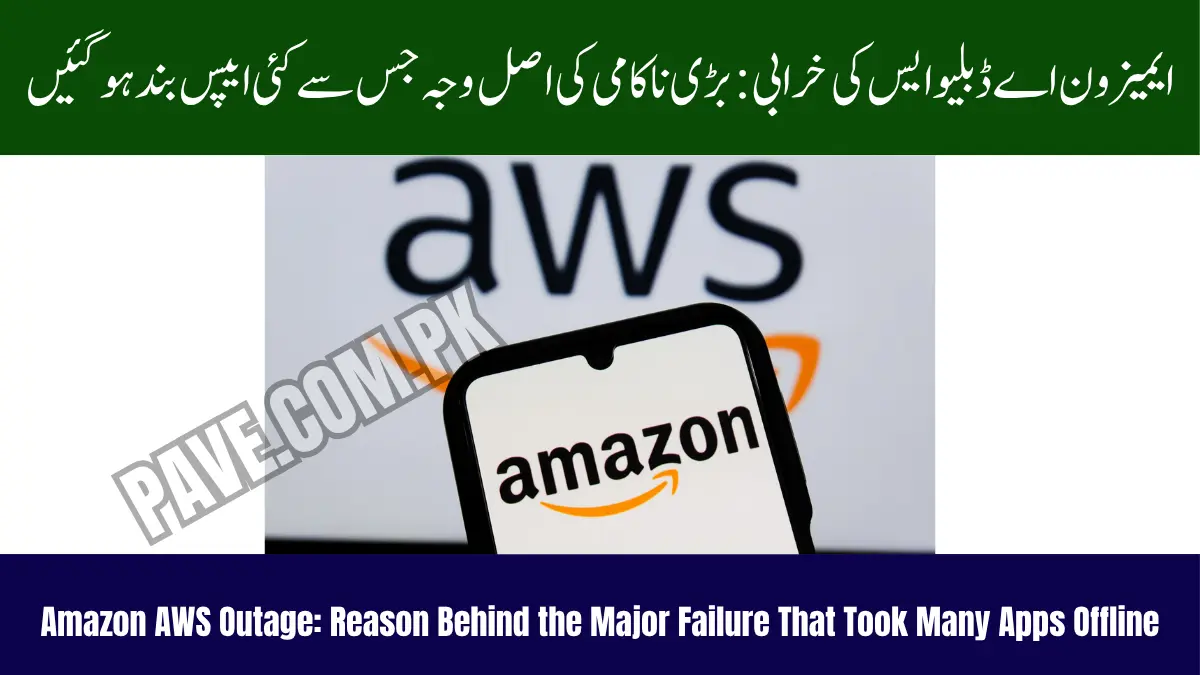Amazon AWS Outage: Reason Behind the Major Failure That Took Many Apps Offline
On 20 October 2025 the world witnessed another dramatic disruption caused by the cloud computing giant AWS (Amazon Web Services). The event raised fresh concerns about the stability of cloud infrastructure, and it forced many major apps and websites offline. This article explores the incident in depth: the Amazon AWS outage, the AWS outage reason 2025, how the Amazon server down today scenario played out, the AWS status update, and what lessons the tech world must draw from the disruption.
The Outage Unfolds
In the early hours of 20 October 2025, users around the globe began noticing interruptions: apps were failing, websites refused to load, transactions froze. Reports quickly pinpointed a central cloud provider as the culprit. Indeed, the Amazon cloud failure 2025 became clear when AWS confirmed a “major disruption” centred in one of its largest data-centres: the US-EAST-1 region in Northern Virginia.
As many observers noted, the outage demonstrated how a single malfunction in the cloud layer can ripple across the internet. The major apps offline due to AWS included social platforms, banking and fintech services, gaming titles, streaming hosts and many more — a stark reminder of how much of the digital world relies on AWS’s backbone.
What Went Wrong? Understanding the Root Cause
Why did the outage happen? The AWS outage root cause investigation reveals a chain of internal failures rather than an external attack. AWS described the incident as stemming from an internal Domain Name System (DNS) issue related to its DynamoDB service endpoint in US-EAST-1. Because DNS translates human-readable addresses into machine IPs, such a failure meant that apps couldn’t find their servers — in effect, they became invisible.
One specialist summarised it: the system had the data, but nobody could “locate” it. The AWS outage reason 2025 thus was not a malicious hack, but a complex internal cascade triggered by a monitoring subsystem fault in AWS’s load-balancing and routing infrastructure. Once that broke, EC2 launches were throttled, Lambda invocations failed or were delayed, and SQS queues built up – all creating a domino effect.
In short, the Amazon AWS outage today scenario emerged because critical services failed to route and launch correctly – not because the physical infrastructure crashed, but because routing and orchestration at the software layer collapsed.
Read More: Is AWS Still Down or Amazon’s AWS Recovering Services Worldwide After Hit by Major Outage
Scope and Scale: What Was Affected?
The breadth of the impact was striking. Hundreds of services reported outages or degraded performance. Among them:
- Social-media apps like Snapchat and Reddit
- Gaming platforms including Roblox, Fortnite
- Fintech services such as Robinhood, Venmo
- Household brands: Amazon itself (including Alexa and Prime), Ring, Duolingo, Canva
- Corporate and governmental services in banking, cloud hosting and more
Because these platforms relied heavily on AWS’s US-EAST-1 region, their failures likewise indicated the risks of heavy dependence on one cloud region. The Amazon cloud failure 2025 also extended to offline commerce, streaming, authentication services and even parts of government infrastructure. The Amazon server down today narrative captured this high-visibility chaos.
Timeline of Events
- Early morning (US East time): Many apps reported sudden failure.
- AWS status page updated: “Increased error rates and latencies in US-EAST-1.”
- Root cause identified: DynamoDB DNS issue / EC2 instance launch failures.
- Mitigation commenced: Throttling requests, prioritising recovery.
- Hours later: Most services restored, though some still faced elevated errors.
- Full recovery reported later in day: AWS confirmed that initial mitigation had been successful.
The AWS outage history has seen similar incidents from the US-EAST-1 region (2017, 2021, 2023) – making the region a high-risk point of failure.
AWS’s Response and Status Updates
AWS issued a series of bulletins:
- A “potential root cause” had been identified.
- Initial mitigations applied: disabling new instance launches in affected zones, clearing queues.
- By mid-day: “Significant signs of recovery.”
- Later: “Underlying DNS issue fully mitigated.”
Their dashboard labelled the situation from “operational issue” to “impacted” to “resolved” in stages. The AWS status update became a focal point for organisations tracking the outage.
Why This Matters for Businesses and Users
This outage wasn’t just a glitch for a few apps. It underscored deeper systemic risks:
- Single-region reliance – When a major cloud provider region fails, so do many dependent services.
- Chain reaction potential – One service (like DNS or a database) failing can cascade into dozens of others.
- Business continuity cost – For hours, commerce froze, and services were unreachable.
- Trust erosion – Users expect “always-on” reliability; outages shake that faith.
- Risk of vendor lock-in – Heavy dependence on one infrastructure provider reduces flexibility when problems hit.
For organisations, this is a wake-up call: diversification, redundancy and resilience must go beyond simple backups.
Lessons and Best Practices from the Outage
Given the event, what should organisations and users take away?
- Multi-region strategy: Don’t rely on US-EAST-1 alone; have alternative regions and fallback plans.
- Graceful failure: Architect apps so that a downstream service failure (like DynamoDB) doesn’t fully crash the product.
- Real-time monitoring: Breakdowns in infrastructure may propagate fast; live dashboards and alerts are critical.
- Chaos-testing: Simulate region failures and DNS issues to validate your response.
- Clear communications: During the outage many users were left in limbo; status transparency matters.
The major apps offline due to AWS incident thus becomes a case study in how even the largest cloud vendor can stumble and how far-reaching the impacts are.
The Bigger Picture: Cloud Resilience in 2025
Cloud infrastructure underpins much of modern society: banking, streaming, government services, IoT, enterprise software. The Amazon cloud failure 2025 event surfaces an uncomfortable truth: even dominant platforms are not infallible.
One key takeaway: organisations should plan for not just availability, but for service degradation. Instead of assuming full capacity, they must ask: if database access fails, how do we serve users? If compute region is restricted, can we switch to another?
Moreover, dependence on one provider (or region) increases systemic risk. The AWS outage history shows repeated failures — not always massive, but recurrent enough to require active risk management.
Did This Outage Affect Your Region?
For end-users wondering “why can’t I use this service today?”, it helps to understand regional impact:
- Users tied to the US-EAST-1 availability zone were hit hardest.
- Global users experienced issues because many services route through that region.
- Even if you weren’t in the U.S., apps you use may depend on US-EAST-1.
- Some latency and delayed responses lingered for hours even after “resolved” status.
Thus the Amazon server down today scenario may overlap with you even if you aren’t directly using AWS.
What Happened Next: Recovery and Aftermath
By the afternoon of the same day, many impacted apps announced recovery. AWS declared full mitigation of the DNS issue and many downstream services returned to normal. Some residual issues (e.g., backlog processing or slow job queues) remained.
Meanwhile, industry commentary focused on preventive measures, regulatory interest (given the scale of the outage) and the reputational impact on cloud providers. The disruption entered the cloud reliability realm as a high-visibility event: the AWS downtime report October 2025 will be referenced in future audits and discussions.
Read More: Amazon AWS Outage Disrupts Globally Causing SnapChat Down
Why It Wasn’t a Cyber-attack
One of the first questions was: “Was the outage caused by a malicious attack?” The answer: almost certainly not. AWS stated the cause was internal and not external hacking. The Amazon cloud failure 2025 stemmed from infrastructure error, not a security breach. Experts highlighted that the issue was a routing/service update gone wrong — a technical oversight rather than a breach of security systems.
Implications for Smaller Businesses and Developers
Start-ups and mid-sized services often leverage AWS for cost-effective scale. The AWS outage history means that such entities must budget not only for cloud costs but also for contingency: what happens if the provider fails? Some questions to ask:
- Do we have local caching to continue operations?
- Can we fallback to another cloud region/provider?
- Are service level agreements (SLAs) enough?
- What is our communication strategy during a widespread outage?
The major apps offline due to AWS were high-profile, but the ripple effect likely hampered smaller services, payment flows, and background jobs in thousands of businesses.
The End-User Angle: You and Me
When your favourite app fails, the reason might trace back to an infrastructure provider thousands of miles away. As an everyday user you felt:
- Login failures
- Polling delays
- Error pages
- Services stopped working
Because of the Amazon Web Services outage, many users millions of miles away were unable to access even simple services. It’s a reminder that the digital world depends on layers we rarely see.
Final Reflections About Amazon AWS Outage
The Amazon AWS outage of 20 October 2025 will be remembered not just for the service interruption, but for what it revealed: the fragility of cloud as we know it. Despite all efforts at redundancy, when a foundational component fails, the consequences are immediate and broad.
From the AWS outage reason 2025 (DNS/DynamoDB problem) to thousands of apps going dark, to the AWS status update and eventual recovery — this incident shines a spotlight on risk, architecture and trust in digital infrastructure.
Organizations large and small must review their exposure: are you relying on a single cloud region? Do you have fallback? What happens if your cloud provider fails? Even in the era of “the cloud”, the physical, regional and architectural realities still matter hugely.
For users, this incident is a prompt to remember that a service outage isn’t just about the app — it might be a ripple from the underlying cloud.
In an age where uptime is taken for granted, this event serves as a wake-up call. The Amazon server down today experience demonstrates that even the biggest provider can falter. How we respond, recover and prepare matters.







